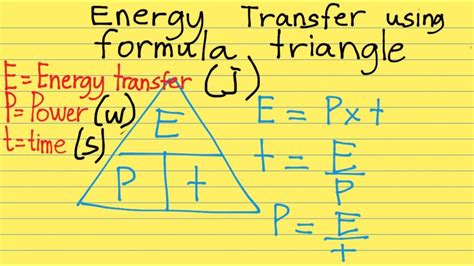The power and energy transfer equation is a fundamental concept in physics and engineering, describing the relationship between the power and energy transferred in a system. This equation is crucial in understanding various phenomena, from the simplest mechanical systems to complex electrical and electronic circuits. In this article, we will delve into the power and energy transfer equation, exploring its components, applications, and implications.
Introduction to Power and Energy

Power and energy are closely related but distinct concepts. Energy refers to the capacity to do work, which can be in various forms such as kinetic, potential, thermal, electrical, or chemical. Power, on the other hand, is the rate at which energy is transferred or converted from one form to another. The power and energy transfer equation provides a quantitative relationship between these two quantities, enabling the calculation of one given the other.
Mathematical Formulation
The power and energy transfer equation is mathematically represented as P = ΔE/Δt, where P is the power, ΔE is the change in energy, and Δt is the time over which the energy transfer occurs. This equation indicates that power is directly proportional to the change in energy and inversely proportional to the time taken for this change. Understanding this relationship is essential for designing and analyzing systems that involve energy transfer, such as engines, generators, and transmission lines.
| Quantity | Symbol | Unit |
|---|---|---|
| Power | P | Watt (W) |
| Energy | ΔE | Joule (J) |
| Time | Δt | Second (s) |

Applications and Implications

The power and energy transfer equation has far-reaching implications across various fields. In electrical engineering, it is used to calculate the power consumption of devices and the efficiency of power transmission systems. In mechanical engineering, it helps in designing more efficient engines and gear systems. Furthermore, understanding the relationship between power and energy is crucial for addressing global energy challenges, such as developing sustainable energy sources and reducing energy consumption.
Energy Efficiency and Sustainability
One of the significant applications of the power and energy transfer equation is in assessing the energy efficiency of systems. By comparing the energy output to the energy input, engineers can evaluate the efficiency of energy conversion processes. This knowledge is vital for developing sustainable energy solutions, as it helps in identifying areas where energy loss can be minimized, thereby reducing the overall energy consumption and environmental impact.
Key Points
- The power and energy transfer equation (P = ΔE/Δt) relates power to the change in energy over time.
- Understanding this equation is crucial for designing and analyzing energy conversion systems.
- It has applications in electrical, mechanical, and civil engineering, as well as in addressing global energy challenges.
- Energy efficiency and sustainability can be improved by optimizing energy conversion processes based on this equation.
- The equation is fundamental in calculating the power output and energy input of systems, helping in evaluating their efficiency and performance.
Technical Specifications and Evidence-Based Analysis
A thorough understanding of the power and energy transfer equation requires a deep dive into its technical specifications and an evidence-based analysis of its applications. For instance, in the context of electrical power systems, the equation can be used to calculate the power factor, which is a measure of how effectively the current drawn from the mains is converted into useful work output. Similarly, in mechanical systems, the equation is essential for determining the mechanical advantage of machines, which is a measure of the ratio of the output force to the input force.
Case Studies and Practical Applications
To further illustrate the significance of the power and energy transfer equation, consider the example of a hydroelectric power plant. The power generated by such a plant can be calculated using the equation P = ΔE/Δt, where ΔE is the potential energy of the water falling from a certain height, and Δt is the time over which this energy is converted into electrical energy. This calculation is critical for determining the capacity of the power plant and its potential to meet energy demands.
In conclusion, the power and energy transfer equation is a foundational principle in physics and engineering, underpinning our understanding of energy conversion and transfer. Its applications span across various disciplines, from electrical and mechanical engineering to sustainability and energy policy. By grasping the intricacies of this equation and its implications, professionals and policymakers can make informed decisions to optimize energy use, reduce waste, and promote sustainable development.
What is the power and energy transfer equation, and why is it important?
+The power and energy transfer equation (P = ΔE/Δt) is crucial because it quantitatively relates power to the change in energy over time, enabling the calculation of one given the other. This relationship is vital for designing and analyzing systems that involve energy transfer.
How does the power and energy transfer equation apply to real-world scenarios?
+The equation has numerous practical applications, including calculating the power output of engines, the efficiency of power transmission systems, and the energy consumption of electrical devices. It is also essential for assessing the sustainability of energy sources and systems.
What role does the power and energy transfer equation play in addressing global energy challenges?
+Understanding the power and energy transfer equation is key to developing sustainable energy solutions. It helps in identifying areas where energy loss can be minimized, thereby reducing overall energy consumption and environmental impact. This knowledge is vital for addressing global energy challenges and promoting sustainable development.
Meta Description: Explore the power and energy transfer equation, its components, applications, and implications in physics and engineering, and discover how it underpins our understanding of energy conversion and transfer.



